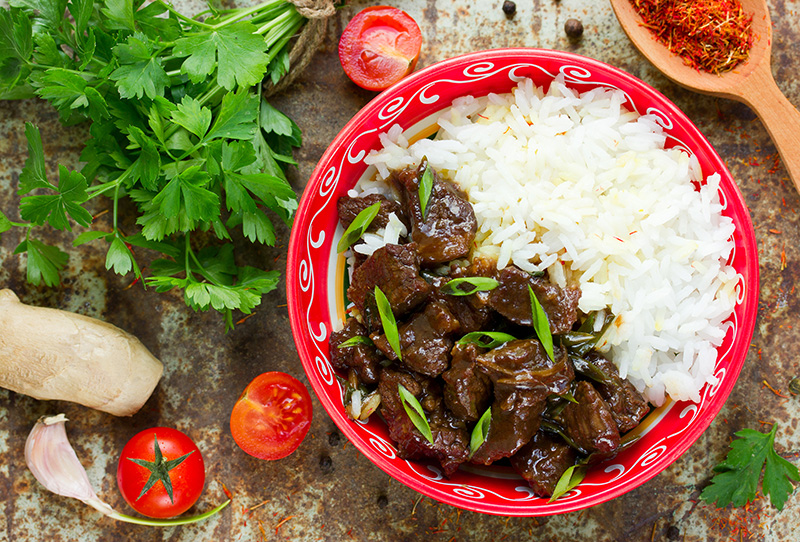There are many dishes we associate with a particular culture that were actually invented or heavily adapted here in Canada. In It's Canadian, Gabby Peyton shares the history behind some surprisingly Canadian foods. Today, Gabby explores the history of Ginger Beef, a Chinese-Canadian dish that originated in Calgary.

Almost every town in Canada has one.
The flickering neon sign beckons the hungry to sit down at plastic tableclothed booths and devour a towering plate of Chinese-Canadian food. From Newfoundland to Nanaimo, these restaurants, primarily owned by first generation Chinese-Canadians, became a staple in our gastronomic history in the 1950s.
I myself have warm memories of crispy deep-fried chicken balls smothered in that extra-sweet and sour bright pink sauce served with sticky brown fried rice. And while the decor in some may be outdated, the Chinese food restaurant in Canada is not a fading phenomenon. In fact, new restaurants are sprouting up across the country. One opened in my hometown of St. John’s just last month — across the street from another Chinese food restaurant.
Many of the dishes served in these eateries are not traditionally Chinese, but the evolutions, adaptations and make-dos of the cooks who’ve been bringing the cuisine as early as the 19th century. Writers like Lily Cho and Ann Hui research the evolution of the Chinese food restaurant in Canada, and in learning this history we begin to understand its influence on the national culinary culture.
Dishes like Ginger Beef have been so ingrained in the Canadian diet, they're as common as leftover meat and potatoes heating up in office microwaves across the country. Ginger Beef is just one of the dishes in the Canadianized compendium, but it’s one of the most prevalent — so prevalent most Canadians don’t know this tangy dish was invented in Calgary.
Steak Dinners and Chop Suey
A pair of sisters immigrated from Hong Kong in 1975 with aspirations of opening a restaurant. Louise Tsang and Lily Wong opened up their eatery in an old cafe known as the Silver Inn in the north of Calgary and started serving both Canadian and Chinese dishes, which was the norm for many restaurant owners of Chinese descent during this period. Many restaurants are the result of a generation of Chinese labourers who set up shop after working on the trans-Canadian railway in the late 19th and early 20th centuries. Because of the head tax on Chinese immigrants, they were basically limited to working in grocery stores, laundromats or restaurants.
Ironically, many of the restaurants opened by new Canadians weren’t serving Chinese food. From Halifax to Vancouver, restaurants were pumping out crowd-pleasing Canadian cuisine like grilled cheese and steak dinners. In fact, the 1931 census reports about 20 percent of restaurants in Canada belonged to owners of Chinese origin.
Once the Chinese Exclusion Act (also known as the Chinese Immigration Act, enacted in 1923) was overturned in 1947, allowing Chinese immigration again, the Chinese restaurant as we know and love it today became much more prevalent. Chop Suey restaurants, among others donning red paper lanterns and dragon carvings, popped up in even the tiniest of Canadian towns. In addition to burgers, pizza and steak, the restaurants started selling Shanghai noodles, wonton soup and, of course, Ginger Beef.
Striking Gold at the Silver Inn

Ginger Beef as we know (and crave) today consists of deep-fried strips of beef coated in a sweet sauce with ginger, garlic and hot peppers, and then tossed with julienned carrots and onions. This dish is a westernized version of fare typically found in Northern China and the province of Hunan, which is much drier with no breading on the beef.
In order to suit the tastes of the North American palate, many Chinese dishes were sweetened. With the help of Lily’s husband, George Wong, the sisters knew they had to adapt certain recipes, and Ginger Beef was born, also known on their menu as “No. 65: Deep fried shredded beef in chili sauce.” Because Wong had experience cooking in England, he was used to the typical Western palate and added the sticky sweet sauce.
The sweet sauce, akin to what Westerners know as gravy, was adapted to suit the pub-obsessed palate of Caucasians both in North America and Britain. And of course they deep-fried the beef, because what Canadian doesn't love something deep-fried? Ironically, the dish has very little ginger in it and it’s actually the sweet chilies that uninformed Caucasian Canadian palates were mistaking for ginger.
Ginger Beef epitomizes the evolution of Chinese-Western cuisine and, while its status as an iconic Canadian dish may be under the radar, there’s no doubt about its popularity and adoration from coast to coast.
MORE READING
- Iconic Canadian Food: Tourtière — Canada's Meat Pie
- Iconic Canadian Food: Beaver Tails — Flat, But Not Boring
- Iconic Canadian Food: Canada's Love Of Ketchup Chips
It's Canadian is written by Gabby Peyton. Gabby is based in St. John’s, Newfoundland and blogs at The Food Girl in Town. She’s a culinary adventurer and freelance writer, focusing on travel, food and drink writing with a dash of historical work. You can follow Gabby on social media at Facebook, Twitter and Instagram.








Hunan is not in Northern China!
Thanks for the heads up! It was supposed to say Northern Chine AND the province of Hunan. That was a big typo!